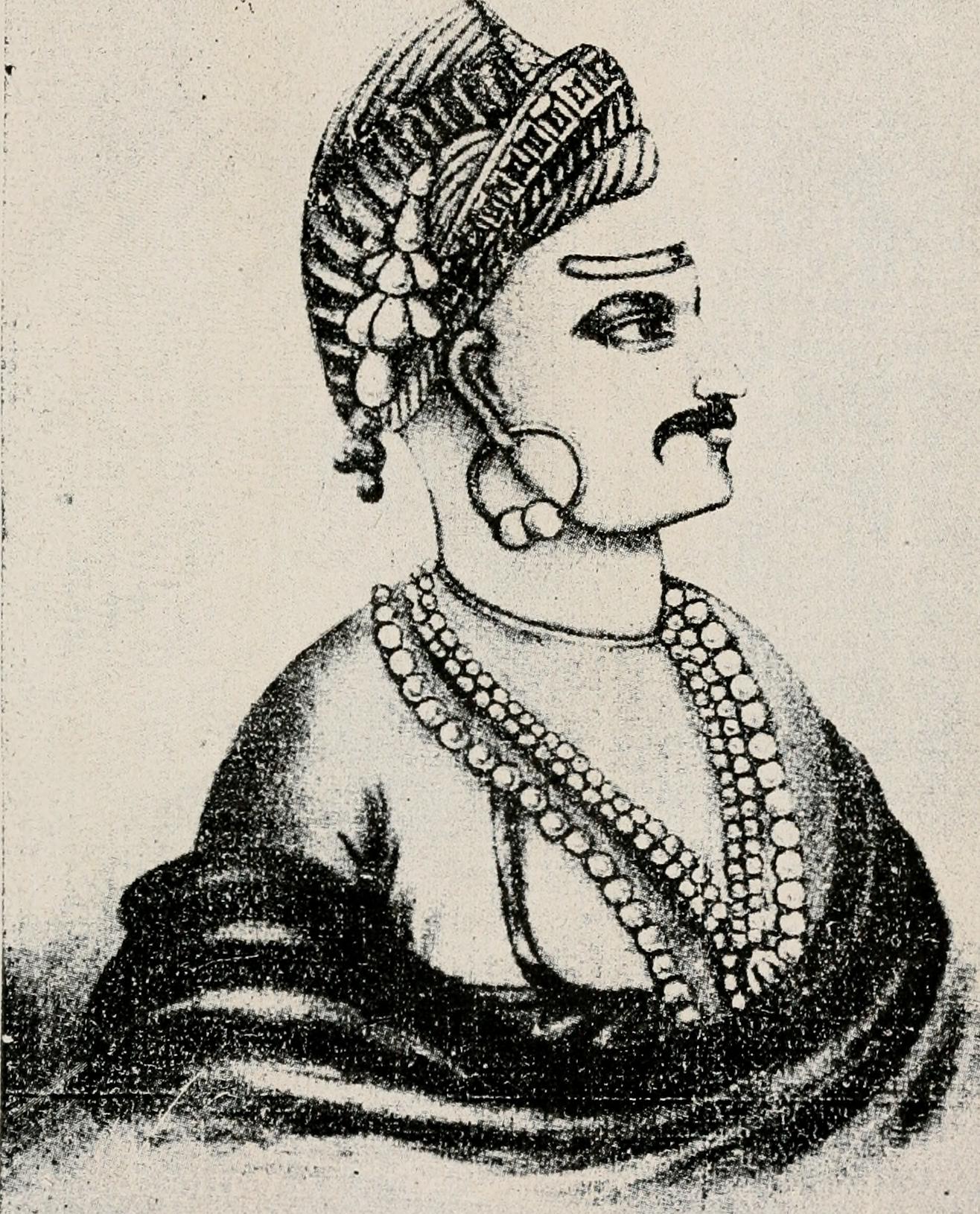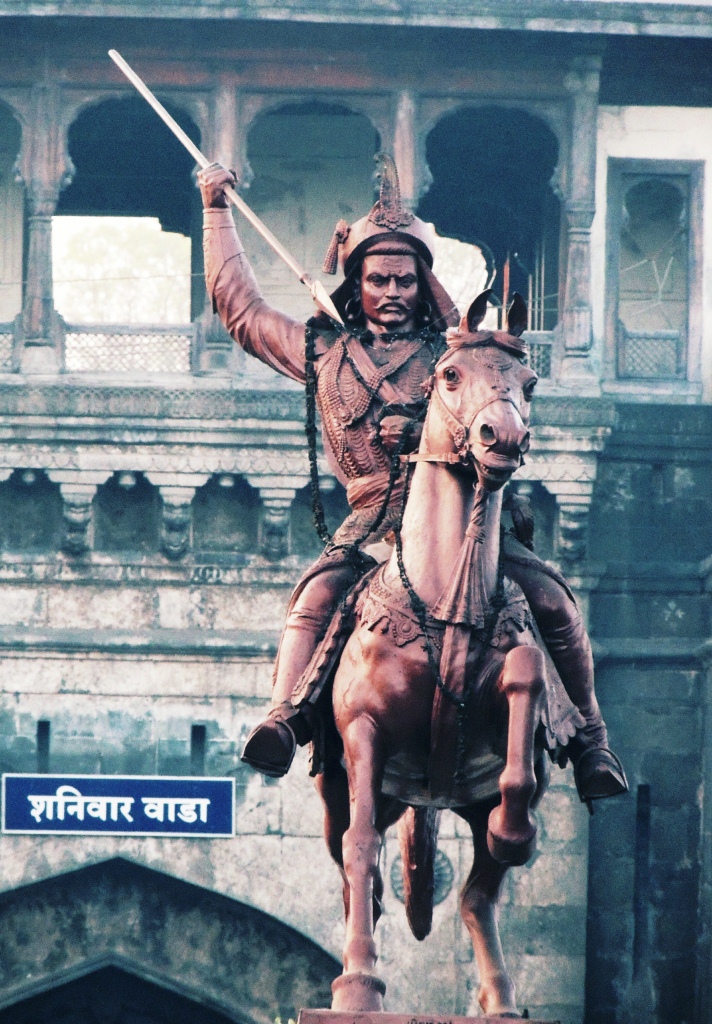|
Anandibai
Anandibai was a Peshwa Queen and the wife of Raghunathrao, the 11th Peshwa of the Maratha Empire. In August 1773, she successfully plotted the death of her nephew, the 17-year-old Peshwa Narayanrao. Her husband was acting regent at the time and next in line for the throne, at the time of Narayanrao's death. Early life and marriage Anandibai was born into a Chitpavan Brahmin family belonging to Guhagar village in the Konkan region of what is now Maharashtra state. She was the daughter of Raghu Mahadev Oak. Her cousin Gopikabai (of the Raste family), was the wife of Peshwa Balaji Bajirao. In December 1756, when Anandibai was yet a child, she was married to Raghunath Rao, younger brother of Balaji Baji Rao. She was his second wife. Raghunathrao's first wife (Janaki Bai of the Barwe family) had died in August 1755. Both Balaji and Raghunath were the sons of Baji Rao I, Peshwa of the Maratha Empire. The position of Peshwa was an administrative appointment made by the Chhatrapati (Ki ... [...More Info...] [...Related Items...] OR: [Wikipedia] [Google] [Baidu] |
Gopikabai
Gopikabai (December 20, 1724 in Supa, near Pune, India – August 11, 1778 in Nashik) was Peshwin of Maratha Empire, as the wife of Peshwa Balaji Baji Rao (also called Nanasaheb Peshwa). She had a very orthodox religious upbringing and belief. After the death of Nanasaheb Peshwa, she tried to expand her power over the Peshwa and the administration. She influenced her son Madhavrao Peshwa, who by sidelining Raghunathrao at her urging, assumed control. However, after trying to interfere in administrative matters, namely to save her brother from punishment, she was confined to Nashik. In 1773 she was freed after the death of Madhavarao and went back to Pune. Afterwards, Gopikabai became part of the priestly class. She developed a rivalry with other women in the Peshwa's household. She was the mother of three successive Peshwas. Childhood Gopikabai was the daughter of Bhikaji Naik Raste of Wai, near Pune. Gopikabai was noticed by Radhabai, the mother of Peshwa Baji Rao I, du ... [...More Info...] [...Related Items...] OR: [Wikipedia] [Google] [Baidu] |
Ram Shastri
Ram Shastri Prabhune was the Chief Justice (''Mukhya Nyayadhish'' or "Pantnyayadhish" ) in the apex court of the Maratha Empire in the latter half of the 18th century, during the heyday of that empire. He is best remembered for having passed strictures against the sitting Peshwa of the time for instigating murder. Ram Shastri's integrity in public affairs is regarded as a model for all times. Biography Ramshastri Prabhune was born in Deshastha Rigvedi Brahmin family in the small town of Kshetra Mahuli also called Sangam Mahuli, near Satara, not be confused with Mahuli. Little is known of his early life, with references to him being available only after he entered the service of the Peshwas. Ram Shastri held office under the Peshwas during the latter part of the 18th century. Known for his honesty and integrity, he even declined a royal gift made to his wife. He turned down the offer of an official mansion and continued to live in his humble ancestral home in the Brahmin quarter ... [...More Info...] [...Related Items...] OR: [Wikipedia] [Google] [Baidu] |
Raghunathrao
Raghunathrao Bhat (a.k.a. Ragho Ballal or Ragho Bharari) (18 August 1734 – 11 December 1783) was the 11th Peshwa of the Maratha Empire for a brief period from 1773 to 1774. He was known among the Hindus for his extremely successful North-western campaign of 1757-58 and for his works to liberate the Hindu holy places of Kashi and Ayodhya. Early life Raghunathrao Bhat, also known as "Raghoba", "Raghoba Dada" and "Ragho Bharari," was the younger brother of Nanasaheb Peshwa. His father was Peshwa Bajirao I & mother was Kashibai. Raghunathrao was born in Mahuli near Satara on 8 December 1734. Much of his childhood was spent in Satara. A small time after his birth, his step-mother, Mastani gave birth to his brother, Krishna Rao, also named Shamsher Bahadur I Maratha conquests In his early years he fought with great success in the north. His expedition during 1753–1755 was concluded by an advantageous treaty with the Jats. Raghunathrao imprisoned Mughal Emperor Ahmad Shah ... [...More Info...] [...Related Items...] OR: [Wikipedia] [Google] [Baidu] |
Bajirao II
Shrimant Peshwa Baji Rao II (10 January 1775 – 28 January 1851) was the 13th and the last Peshwa of the Maratha Empire. He governed from 1795 to 1818. He was installed as a puppet ruler by the Maratha nobles, whose growing power prompted him to flee his capital Poona and sign the Treaty of Bassein (1802) with the British. This resulted in the Second Anglo-Maratha War (1803–1805), in which the British emerged victorious and re-installed him as the titular Peshwa. In 1817, Baji Rao II joined the Third Anglo-Maratha War against the British, after they favoured the Gaekwad nobles in a revenue-sharing dispute. After suffering several battle defeats, the Peshwa surrendered to the British, and agreed to retire in return for an estate at Bithoor and an annual pension. Personal life Baji Rao was the son of the former ''Peshwa'' Raghunathrao and his wife Anandibai. Raghunathrao had defected to the English, causing the First Anglo-Maratha War, which ended with the Treaty of Sal ... [...More Info...] [...Related Items...] OR: [Wikipedia] [Google] [Baidu] |
Chitpavan
The Chitpavan Brahmin or Konkanastha Brahmin is a Hindu Maharashtrian Brahmin community inhabiting Konkan, the coastal region of the state of Maharashtra. Initially working as messengers and spies in the late seventeenth century, the community came into prominence during the 18th century when the heirs of Peshwa from the Bhat family of Balaji Vishwanath became the de facto rulers of the Maratha empire. Until the 18th century, the Chitpavans were held in low esteem by the Deshastha, the older established Brahmin community of Maharashtra region. As per Jayant Lele, the influence of the Chitpavans in the Peshwa era as well as the British era has been greatly exaggerated because even during the time of the most prominent Peshwas, their political legitimacy and their intentions were not trusted by all levels of the administration, not even by Shivaji's successors. He adds that after the defeat of Peshwas in the Anglo-Mahratta wars, Chitpavans were the one of the Hindu communitie ... [...More Info...] [...Related Items...] OR: [Wikipedia] [Google] [Baidu] |
Rama Madhav
''Rama Madhav'' is a 2014 Indian Marathi-language historical drama directed by Mrinal Kulkarni, It takes place during the Peshwa era. ''Rama Madhav'' was released on 8 August 2014. Plot The story starts from where Chhoti Rama is playing. All she knows as a child is that she was married to the son of a Peshwa. As a child, Rama enters Shaniwarwada for the first time wearing saree and at a very young age she has a responsibility. Nanasaheb Peshwa, who was devastated by the defeat at Panipat and was disappointed by Vishwasrao's death, Madhavrao gets the post of Peshwa at very young age. Cast * Alok Rajwade as Madhavrao I * Parna Pethe as Ramabai Peshwa * Ravindra Mankani as Peshwa Nanasaheb * Mrinal Kulkarni as Gopikabai * Prasad Oak as Raghunathrao * Sonalee Kulkarni as Anandibai * Amol Kolhe as Sadashivrao Bhau * Shruti Marathe as Parvatibai * Shruti Karlekar * Suchitra Bandekar * Aditi Rao Hydari in special appearance Critical response Namita Nivas of ''Indian Express ... [...More Info...] [...Related Items...] OR: [Wikipedia] [Google] [Baidu] |
Sonalee Kulkarni
Sonalee Benodekar (née 'Kulkarni; born 18 May 1988) is an Indian actress who mainly acts in Marathi cinema and Bollywood films. After working as a model in her early career, Sonalee made her debut in Kedar Shinde's film Bakula Namdeo Ghotale, for which she received the ''Zee Gaurav Puraskar'' award for best actress. She is noted for her lavani dance song, "Apsara Aali" in the Marathi film ''Natarang'', followed by '' Kshanbhar Vishranti'', '' Ajintha'', and '' Zapatlela 2''. In 2014, she was seen alongside Swapnil Joshi and Prarthana Behere in '' Mitwaa'' for which she was nominated at '' Zee Gaurav Puraskar'' in the category of Best Actress. She made her Hindi film debut in the adult sex comedy '' Grand Masti'' wherein she played the role of Mamta, wife of Ritesh Deshmukh's character. Sonalee also made a cameo appearance in the Ajay Devgan picture ''Singham 2''. Early life Sonalee Kulkarni was born to Manohar and Savinder Kulkarni in the army cantonment of Khadki, near ... [...More Info...] [...Related Items...] OR: [Wikipedia] [Google] [Baidu] |
Narayanrao Peshwa
Narayanrao Bhat (10 August 1755 – 30 August 1773) was the 10th Peshwa of the Maratha Confederacy from November 1772 until his assassination in August 1773. He married Gangabai Sathe who later gave birth to Sawai Madhavrao. Early life Narayanrao Bhat was born 10 August 1755. He was the third and youngest son of Balaji Baji Rao (also known as Nana Saheb) and his wife Gopikabai. He received a conventional education in reading, writing and arithmetic and possessed a functional understanding of Sanskrit scriptures. He was married to Gangabai Sathe on 18 April 1763 before his eighth birthday. Gangabai was born in Kelashi village and belonged to Sathe family . Her father's name is not known, but Keshav Vinayak Sathe was the family head. Sathe's were the dashagranthi brahmins and were serving as priests of Kelashi's Mahalakshmi. Ruins of Gangabai's house are still present in Kelshi village near a small Datta Mandir. He was very close to Parvatibai, the widow of Sadashivrao, who ... [...More Info...] [...Related Items...] OR: [Wikipedia] [Google] [Baidu] |
Shaniwar Wada
Shaniwar Wada is a historical fortification in the city of Pune, India. Built in 1732, it was the great seat of the Peshwas of the Maratha Empire until 1818. Following the rise of the Maratha Empire, the palace became the center of Indian politics in the 18th century. The fort itself was largely destroyed in 1828 by an unexplained fire, but the surviving structures are now maintained as a tourist site. History The Shaniwar Wada was normally the seven-story capital building of the Peshwas of the Maratha Empire. It was supposed to be made entirely of stone but after the completion of the base floor or the first story, the people of Satara (the national capital) complained to the Chatrapati Shahu Maharaj(King) saying that a stone monument can be sanctioned and built only by the king himself and not the Peshwas. Following this, an official letter was written to the Peshwas stating that the remaining building had to be made of brick and not stone. Even today if you visit and see ... [...More Info...] [...Related Items...] OR: [Wikipedia] [Google] [Baidu] |
The Great Maratha
''The Great Maratha'' is an Indian historical drama television series directed by Sanjay Khan and produced by Numero Uno International Limited. The drama aired on DD National. The series is based on the life of Mahadaji Shinde. The show comprised 47 episodes. The music was composed by Mohammed Zahur Khayyam. Cast * Bal Dhuri as Balaji Baji Rao * Shahbaz Khan as Mahadji Scindia * Farida Jalal as Chima Bai * Kartika Rane as Jamuna Bai/Yamunabai * Deepraj Rana as Jankoji Rao Scindia * Pankaj Dheer as Sadashivrao Bhau * Sanjay Swaraj as Vishwasrao * Mangal Dhillon as Dattaji Rao Scindia * Firoz Ali as Tukoji Rao Scindia * Mukesh Khanna as Ibrahim Khan Gardi * Rajesh Joshi as Vithal Shivdev Vinchurkar * Gaazi Shah as Rana Khan * Shama Deshpande as Gopikabai * Rahul Awasthee as Madhavrao I * Madhura Deo as Ramabai Peshwa * Rinku Dhawan as Gangabai Sathe * Hariom Parashar as Nana Phadnavis * Parikshat Sahni as Malhar Rao Holkar * Mrinal Kulkarni as Ahilyabai Holkar * Seema Ke ... [...More Info...] [...Related Items...] OR: [Wikipedia] [Google] [Baidu] |



.jpg)
